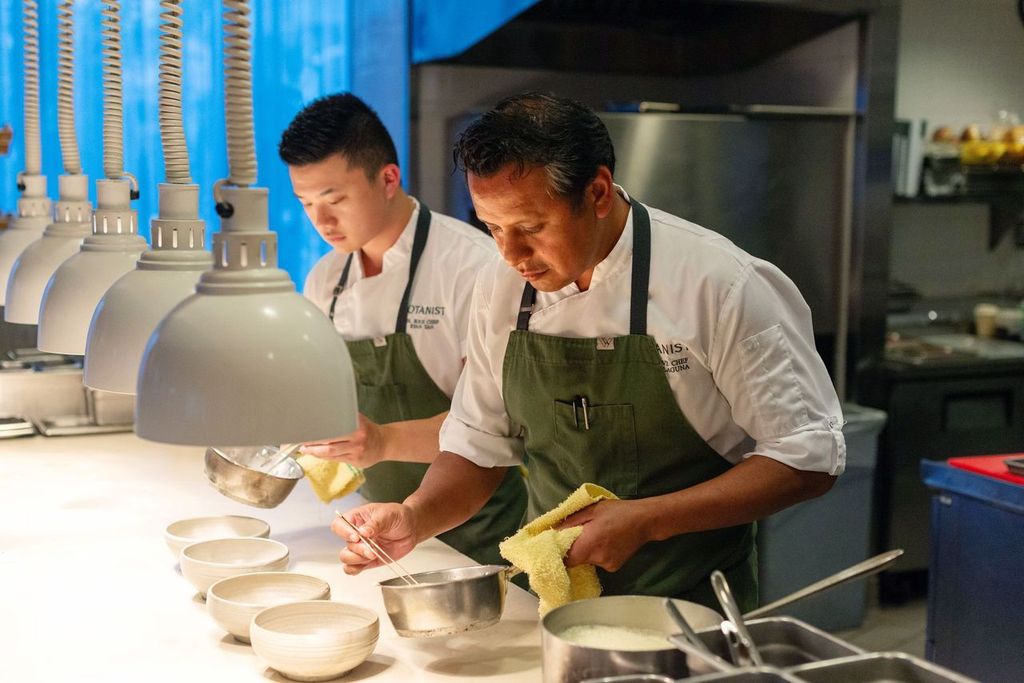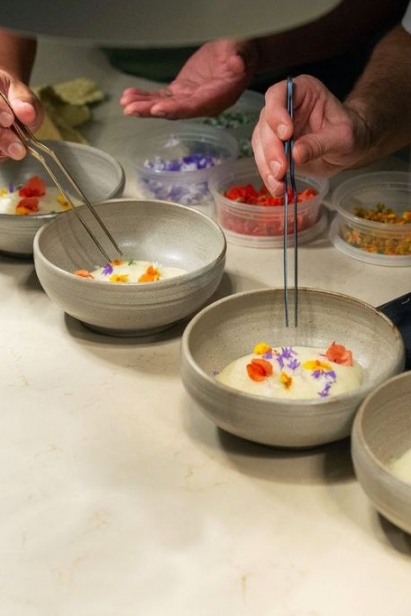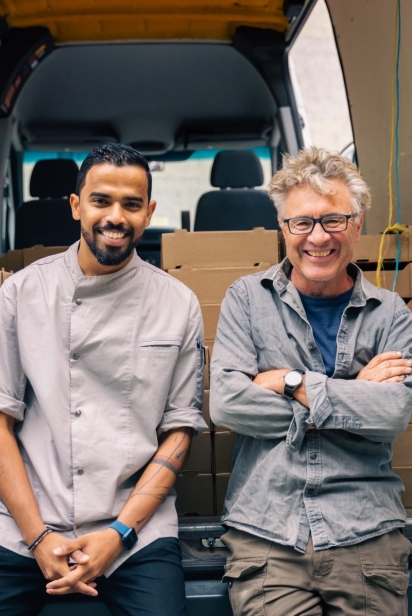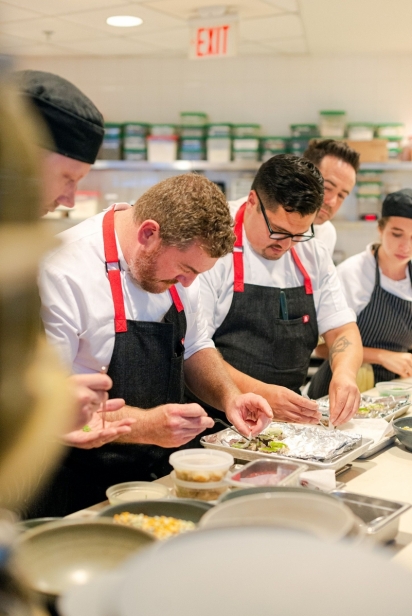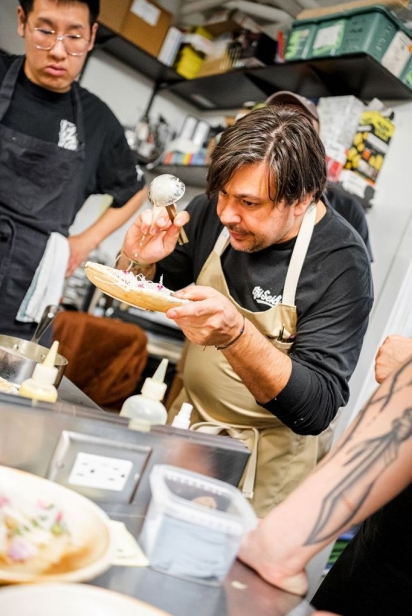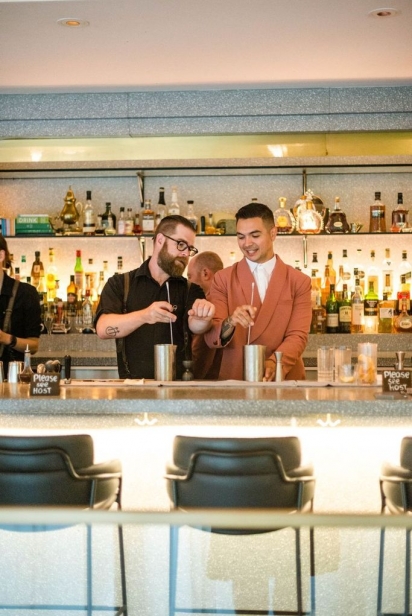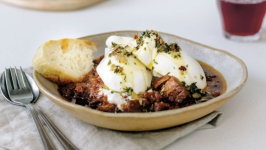All Together Now
Collabs are cool. All the hottest chefs are doing them. And all the savviest diners are happily shelling out a couple hundred bucks to sit at their tables, savour what they’re serving and post it on Instagram.
Sometimes that table is a long one that seats 200 people in a farmer’s field; sometimes it’s a stainless steel counter that seats eight in a restaurant kitchen. But it’s always the setting for course after course of creative dishes curated just for this one occasion. The chefs, meanwhile, come with dazzling credentials — Michelin stars, nods from enRoute or Canada’s 100 Best, recently published cookbooks or recognition as a “rising star.” And the wine pretty much always flows as merrily as the conversation.
If you’ve never been to a chef collaboration event, you may wonder what all the fuss is about. But those who do go know that the experience can be sublime.
It’s exciting when the chef of a revered restaurant such as Patrick Kriss of Toronto’s Alo (currently No. 2 on Canada’s 100 Best Restaurants list) or Jason Bangerter of Langdon Hall (No. 7) comes to town and cooks with Hector Laguna at Botanist Restaurant or J-C Poirier at St. Lawrence.
Between courses, they hang out in the dining room and chat with the guests, giving us a peek behind the kitchen door and making us feel, for a couple of hours, as if we’re part of a special club — one with really, really good food. We go home with a warm glow, sometimes with a goody bag and always with anecdotes on which to dine out for months to come.
But we couldn’t help wondering: What’s in it for the chefs? Are they having as much fun as we are? And what does it take to put one of these things on? So we asked them.
Education and recognition
“I’ve done so many now. We’ve gotten so good at these things, it comes naturally to me,” says Gus Stieffenhofer-Brandson, executive chef of the Michelin-starred Published on Main. “I think RAW:almond and its offshoots remain my favourite and it’s because of all my friendships and alignment with Mandel.”
“Mandel” is Mandel Hitzer, the chef at Winnipeg’s Deer + Almond and the co-founder of RAW:almond, an annual series of dinners held in a temporary structure that pops up on a frozen river. (The other co-founder is Joe Kalturnyk, founding director of RAW:Gallery of Architecture and Design.) Each year, 20 world-class chefs from across Canada and beyond descend on the ’Peg in the sub-zero depths of winter to cook wildly creative food in this unlikely setting.
Stieffenhofer-Brandson is typically one of them. He’s also cooked with Hitzer in, among other places, Churchill, Manitoba, and at the Terroir conference in Calgary. “We still keep coming up with fun food,” he says. “It’s wild to make these dinners happen in lessthan-optimal circumstances. It involves a lot of critical thinking.”
Organizing a chef collab takes time and effort. But ask a chef why he — or, less often, she or they — wants to do it, and they’ll tell you how great it is to work with their friends, to challenge themselves, to learn something new and to earn recognition with like-minded colleagues.
“The easy answer is ‘I’m an idiot.’ It’s a lot, a lot of work,” Laguna says. He laughs a little. “But it’s a lot of fun for me and more important, it’s a lot of fun for our guests.”
He’s done many collabs with big-name chefs, some from restaurants with constellations of Michelin stars, and says, “All have been amazing, really, really easy to work with. We’re really excited to meet them, to see how they do things. It’s always a learning experience.”
He also points out that the main reason to do these events is as a benefit for his guests. “A hundred per cent of the people who come have been here before,” Laguna says, noting that he will personally call and let regulars know about an upcoming dinner. “Bottom line, it just shows them we appreciate them.”
Dishing out drinks, too
It’s not just the chefs who are collaborating. The bar team at Botanist and the Fairmont Pacific Rim where it is located includes several Diageo World Class Canada winners, and they regularly invite their colleagues from top bars such as Hanky Panky in Mexico City or Katana Kitten in New York to come and shake up some good times.
“We don’t have the luxury of being in a major hub like New York or L.A., so we reach out to bars we respect,” says Grant Sceney, the creative beverage director at Botanist. “Obviously, we are a business. We want to work with the best and we want to align ourselves with the best.”
The bartenders share their expertise, raising each other up through education. “That’s the best way to be a leader in the community,” Sceney says. “It really works well to support the community.”
Shelome Bouvette, the former chef-owner of Chicha, who is currently launching an empanada business, agrees that collabs are a good way to learn something new, whether it is a new dish, a different technique or the cuisine from an unfamiliar region.
“I really like doing it because it’s a way to do something that’s not your everyday,” she says. “Sometimes if you’re feeling you’re getting a little stale with your creativity, it’s great to spend a day with another chef. Sometimes it takes you out of your comfort zone a little bit.” Adds Stieffenhofer-Brandson: “It’s always interesting to do something outside of your usual service. There’s so much knowledge to be shared.”
Logistics upon logistics
But how, exactly, does a chef collab come together?
It usually begins with an email or a phone call. Maybe one chef has a book to promote and is looking for an excuse to visit Vancouver in January. Maybe they met at a conference such as Terroir or CooksCamp. Maybe they belong to the same hotel or restaurant group. Or maybe they’ve just heard about each other and thought they’d work well together.
“Somebody you really look up to, you can send them an email and see if they’ll come out and cook with you, and sometimes they will,” Bouvette says.
Once they’ve decided a collab is a good idea, it can take months to organize. “First, getting in touch with them and finding a date that works for both of us is very complicated for such busy people,” Laguna says.
“There’s a lot of back and forth with people’s schedules,” Sceney adds. “Their schedules, travel schedules, the change of seasons — it’s a lot of logistics, but it’s worth it.”
Those logistics can include things such as dealing with customs if a chef is bringing liquor or special ingredients from outside the country or, if a chef doesn’t have their own restaurant, rental fees and contracts, permits, special events licences and insurance. In fact, insurance can be an issue even in a restaurant. “A lot of restaurants don’t want to be responsible for what you do on site, so you’re not covered,” says Deseree Lo, a private chef who was the runner-up on Season 10 of Top Chef Canada.
And, because the chefs are working in an unfamiliar space on an unfamiliar menu, prep can take three or four days. “I love it when it’s all over. I love it when I see customers coming and having a good time,” Lo says.
There is also seasonality to consider, especially when it comes to creating the menu. “Honestly, that part is exciting and a lot of fun,” Laguna says.
How it works
A collaborative menu can work in a number of ways and it depends a little on how many chefs are in the kitchen. If there are only two, they can alternate courses; if there are more, each can take one or two dishes. They can also work together on each dish, but most chefs want to showcase their own work, and who can blame them? Even so, each dish has to work with every other one as part of a whole.
When Stieffenhofer-Brandson starts planning a chef collab menu, he begins the conversation with: “What are we trying to say, what are we going to do with this menu? It’s always based on our seasonal availability.”
The menu will start with snacks, followed by five to seven courses, and ends with a couple of sweets. Sometimes it will be served family style; other times, it will be plated. Each style has its own set of logistics, as does the space where the chefs are prepping, cooking and serving, not to mention the beverage pairings.
“It’s hectic and these are long days, but overall it’s a positive for the whole team,” he says. Except when it isn’t.
Hierarchy and other hindrances
“I’ve had mixed experiences,” says Shelley Robinson, a Kelowna based culinary consultant, cookbook author and the 2014 winner of Food Network’s Chopped Canada. “I’ve been fortunate enough to do some really fantastic collaborations with some chefs and not-so-good collaborations with other chefs.”
She adds: “I don’t want to come across as not being collaborative, but I speak for a lot of other chefs when I say these events are not very inclusive.”
The reality is that restaurant kitchens are structured around hierarchy and when you throw media attention, awards and celebrity into the mix, you can have some pretty big egos to contend with. Robinson’s “not-so-good” experiences have typically been with “mega-macho” male chefs who dole out courses based on who they consider the biggest stars, with the lone female chef inevitably stuck with dessert. “And I’m not a pastry chef,” she says. “It doesn’t seem fair and equitable.”
It also doesn’t sound like what she thinks a collaboration should do: raise each other up and showcase the work of the team, not an individual.
“I can only speak from my own experience, which is as a female chef. I see the guys, there’s this close, hey-brother kind of thing. I think the guys get really tight-knit. Maybe there’s just not enough gals doing it,” Robinson says.
“At the end of the day, when you think about all the things you have to do with your life, if you’re running a home and a business, the last thing I want to do is put myself into a situation where I feel less than.”
It’s one reason so many collabs are done by male chefs. But, Lo points out, “As for female chefs, there’s not many of us out there. There’s not really a lot of ‘me’ out there, to be honest.”
Male, female or non-binary, there are hindrances for all chefs.
Collabs mean they have to work on their rare days off. Chefs who work as caterers or private chefs often have to rent a space, with all the extra work that entails. A smaller restaurant will have to close for the event, potentially alienating regulars. A larger one, especially in a hotel, will have to keep offering the day-to-day service while adding the work of a collab on top.
Plus collabs are rarely lucrative. Tickets can be hard to sell, especially in Vancouver, where everyone leaves things to the last minute, and there’s a delicate balance between covering rising food costs and charging more than the market will bear.
“Don’t think of this to make money,” Lo says. “You’re not going to make money. Do it for the love of it.”
And despite all the headaches, chefs really do love doing collabs — almost as much as we enjoy going to them.
Building Community
“Of course you want to do collaborations,” Lo says. “It’s completely your own freedom creatively, cooking with your friends. To have a collaboration, it’s a great idea. Chefs meeting chefs and putting your name out there, and you don’t have to be famous. That’s how you get famous.”
She adds: “It’s nice to cook with someone that brings flavours out of your food. It’s a mind-blowing experience. There’s also a lot to take away for the customers.”
For a chef at any stage of their career, it’s educational and inspirational, too.
“My biggest inspiration comes from working with amazing chefs — from chefs and their stories,” says Vish Mayekar, head chef at Caffe La Tana and Pepino’s Spaghetti House. “Doing collabs gives me joy, right from the first phone call. I just like working with people who have the same career. And it keeps my ego in check, too. It humbles you when you work with another chef.”
More than anything else, what a collaboration does is forge connections, or as Sceney says, “You make a friend you don’t know yet.”
“The most important thing is that it brings people together and it encourages building a culinary community. And it forces you to do things that you normally wouldn’t do,” Stieffenhofer-Brandson says.
“I love it. Every time you work with someone else, you learn something new. It’s special to be in someone else’s space or to welcome someone into your space.”


